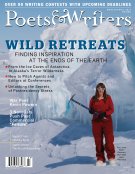In 1993 Lee Gutkind had the urge to build a forum for the best conversation around: the new literary nonfiction. Two decades later, his Pittsburgh-based quarterly, Creative Nonfiction (www.creativenonfiction.org), has established itself as the voice of the genre and is celebrating its fiftieth issue with a double-sized release that includes an excerpt from Gutkind’s memoir-in-progress and a collection of memorable essays from the journal’s history, such as Lauren Slater’s “Three Spheres” and “Ramalamadingdong” by Elena Passarello. Creative Nonfiction’s spring issue, themed “The Human Face of Sustainability,” features an interview with Elizabeth Kolbert and a prizewinning essay by Mary Heather Noble on carcinogenic contaminants. Creative Nonfiction accepts submissions by mail and online through Submittable year-round.
Originally established as a book-review outlet in 1977, the biannual Brick (www.brickmag.com) has since grown into an elegant Canadian cousin to Creative Nonfiction, with each issue featuring literary nonfiction such as “memoirs, travelogues, belles lettres, and unusual musings.” Former editor Michael Ondaatje once described Brick as an “anthology of enthusiasms,” with its back-issue catalog boasting nonfiction luminaries Javier Marias, Marilynne Robinson, and many others. Issue 92 continues the tradition, with a transcript of Ali Smith’s inaugural Harriet Martineau Lecture commemorating Norwich, England’s new “City of Literature” status; an interview with engaging social philosopher Richard Sennett; and Elizabeth Farnsworth’s elegiac essay on the rapidly changing landscape of North Dakota. Brick accepts submissions of nonfiction year-round by postal mail.
Across the pond, the latest issue of the White Review (www.thewhitereview.org)—the sumptuously designed quarterly from London—continues the publication’s reputation for putting out some of today’s best nonfiction. Founded in 2011 by Jacques Testard and Benjamin Eastham, the White Review is an avant-garde journal focusing on “artistically or educationally meritorious works of new or emerging artists and writers.” Issue Nine includes Patrick Langley’s fascinating, celluloid-infused essay on London’s Silvertown district; Enrique Vila-Matas’s musings on the novel; and an interview with pioneering essayist Rebecca Solnit. The White Review accepts e-mail submissions of nonfiction as well as poetry, fiction, and translations year-round for both the print edition and the website.
Though not just nonfiction-focused, the latest issue of Ann Kjellberg’s Little Star (www.littlestarjournal.com)—an annual journal of poetry and prose created in the minimalist “little magazine” tradition—has some not-to-be-missed material for the literary-minded nonfiction reader. First is a grounds-eye view of the birth of Parisian modernism in an excerpt from Rosanna Warren’s captivating biography-in-progress of Max Jacob. Second is a series of newly discovered letters that W. G. Sebald wrote to his English-language translator, Michael Hulse, while working on his masterpiece The Emigrants; the letters should be a nice complement to readers of Sebald’s posthumous nonfiction work, A Place in the Country, published last month by Random House. Little Star accepts submissions year-round by e-mail and postal mail.
Published since 2005 at the University of North Carolina in Wilmington, the semiannual Ecotone (www.ecotonejournal.com) also boasts plenty of offerings for the truth-telling set, with recent essays by Rick Bass, Beth Ann Fennelly, and Lia Purpura, and many works anthologized in Best American Essays. Issue 16, the journal’s first under new editor Anna Lena Phillips, includes “While Our Backs Are Turned,” an essay by Clarisse Hart about the demise of the eastern hemlock; a reprint of Angela Carter’s short story “The Company of Wolves,” introduced by Jim Shepard; a debut story by Elliot Ackerman, a military officer who served five tours in Iraq and Afghanistan; and poetry by Heidi Lynn Staples composed of words gleaned from the trash. The lines between truth and fiction are blurry, of course, an idea that the Ecotone editors have addressed in their new anthology, Astoria to Zion: Stories of Risk and Abandon From Ecotone’s First Decade, published this month and comprising collected fiction from past issues. As the mission of the journal is to “reimagine place,” it’s no wonder that stories in the book make the familiar world feel so strange. Ecotone considers submissions online via Submittable and by postal mail from August 15 to April 15.
Travis Kurowski is the editor of Paper Dreams: Writers and Editors on the American Literary Magazine, published in 2013 by Atticus Books. His website is traviskurowski.com.









